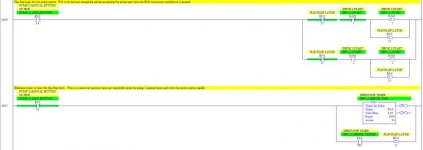I am trying to make a output go on and stay on by pressing a momentary button on my hmi (Panelview 800) Then when I press again I want the output to go off. I can see the bit change state when I press the button but the output does not go on at all. What am I doing wrong? The bits and the outputs are used nowhere else in the program and the routine is being called.
Why doesn't my logic work?
- Thread starter Levi G
- Start date
Similar Topics
Hello I have In touch 10.1
I tried to enter the WindowMaker to make some adjustments I am using a dongol for the license . I can access the...
Hello guys, I'm trying to use the Lenze GDC 4-14 with the system bus adapter 2177, but it doesn't appear in the communication window. It's like I...
I am noticing a problem where i am using MOV instruction and writing literal text into source and String datatype in destination. It works fines...
Hello Folks!
I have an issue and its very often but in this case i applied all the tricks and tips that i always do in similiar issues but in this...
Hello all,
I have a Panelview 550 Cat 2711-K5A5 that has one Serial port ( RS-232). Which I can talk to via my cable via DF1. Which is weird...




